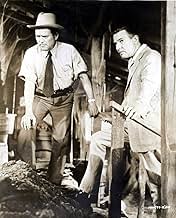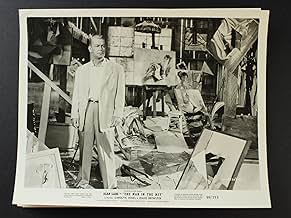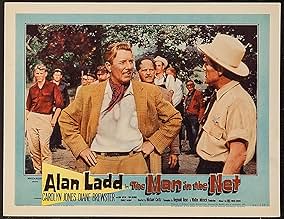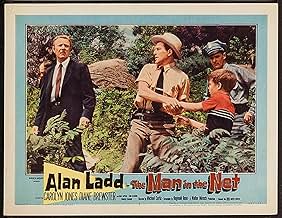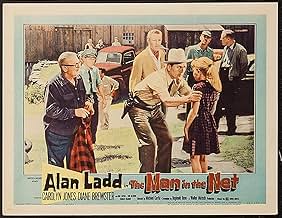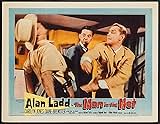VALUTAZIONE IMDb
6,1/10
877
LA TUA VALUTAZIONE
Aggiungi una trama nella tua linguaA struggling artist in a small town becomes the prime suspect when his wife mysteriously disappears.A struggling artist in a small town becomes the prime suspect when his wife mysteriously disappears.A struggling artist in a small town becomes the prime suspect when his wife mysteriously disappears.
Diana Brewster
- Vickie Carey
- (as Diane Brewster)
Michael McGreevey
- Buck Ritter
- (as Mike McGreevey)
Dee Carroll
- Psychiatrist's Nurse
- (non citato nei titoli originali)
Bill Cassady
- State Trooper
- (non citato nei titoli originali)
Alvin Childress
- Alonzo
- (non citato nei titoli originali)
Recensioni in evidenza
Alan Ladd, (John Hamilton) plays the role of an artist who decides to leave New York and the rat race mainly because his wife likes to drink and is getting out of control where she has to see a doctor for help. Carolyn Jones, (Linda Hamilton) plays John's wife and lives in a very quiet town in New England where John paints pictures of children all day and never seems to sell a picture. One day John receives a letter offering him a job in New York City with an Art Firm for $30,000 dollars but refuses to take this position because of his wife's chemical dependency. Linda goes into a rage and starts drinking and goes completely out of control. In real life, Alan Ladd is really doing all the boozing and you can see it in the close up's of his face and eyes are puffy. The children in this picture take complete control over the entire film and gave great supporting roles in trying to hid and help John Hamilton from the police.
There's a nice New England feel in the Connecticut opening scenes of THE MAN IN THE NET and director Michael Curtiz makes striking visual use of the B&W camera in artfully photographing a country farmhouse with its rustic interiors full of paintings supposedly done by local artist ALAN LADD.
Ladd's wife, CAROLYN JONES, doesn't share his passion for the arts, staging quite a scene with neighbors when she breaks into a birthday party with a shiner and accuses her husband of mistreating her during one of their arguments. It provides a nice set-up for someone to eventually murder her, making Ladd look like the main suspect.
Alan Ladd, only 46 at the time, seems almost lifeless and delivers a completely stiff performance that has him befriending neighborhood kids in such a fashion that they become willing to help him avoid detection when the villagers turn on him. This aspect of the story simply rings false, as does the rest of the plot which is too pat and contrived to seem plausible. The children are not exactly adept at delivering most of their lines.
DIANE FOSTER does a nice job as a decent neighborhood woman who helps Ladd prove his innocence and CHARLES McGRAW, JOHN LUPTON and TOM HELMORE are fine as other suspects in the supporting cast.
But for a man accused of a crime he didn't commit, Ladd has all the facial animation of a department store mannequin.
Trivia note: The bit about the slashed paintings reminds me of the Ronald Colman/Ida Lupino flick THE LIGHT THAT FAILED, but Jones' emoting in the party scene is on the level of Bette Davis at her histrionic overkill.
Ladd's wife, CAROLYN JONES, doesn't share his passion for the arts, staging quite a scene with neighbors when she breaks into a birthday party with a shiner and accuses her husband of mistreating her during one of their arguments. It provides a nice set-up for someone to eventually murder her, making Ladd look like the main suspect.
Alan Ladd, only 46 at the time, seems almost lifeless and delivers a completely stiff performance that has him befriending neighborhood kids in such a fashion that they become willing to help him avoid detection when the villagers turn on him. This aspect of the story simply rings false, as does the rest of the plot which is too pat and contrived to seem plausible. The children are not exactly adept at delivering most of their lines.
DIANE FOSTER does a nice job as a decent neighborhood woman who helps Ladd prove his innocence and CHARLES McGRAW, JOHN LUPTON and TOM HELMORE are fine as other suspects in the supporting cast.
But for a man accused of a crime he didn't commit, Ladd has all the facial animation of a department store mannequin.
Trivia note: The bit about the slashed paintings reminds me of the Ronald Colman/Ida Lupino flick THE LIGHT THAT FAILED, but Jones' emoting in the party scene is on the level of Bette Davis at her histrionic overkill.
In "the proud rebel" , Alan Ladd played opposite a child,his own son ; in the very first sequence,he is surrounded by a bunch of kids who do not think his drawings are "dirty "; this sequence is rather long and may seem boring and soppy ;but it's vital .Hadn't the artist been good friends with the children of the neighbourhood, he would have been perhaps lynched by the populace -although it's a bit exagerated , his wife being not so popular in the vicinity.
The murder mystery is quite trite ,with the cardboard character of the alcoholical hysterical wife (Carolyn Jones ) ,and the trap the fugitive uses to clear himself of the accusation somewhat far-fetched .
The film's main interest lies in the children's intervention ,the last bastion against the maddening crowd ; for them ,it's the greatest game they have ever played ,and to hide the fugitive in their own "den" is extremely exciting ;their relationship with the wrong man makes up for the paucity of the detective story.
The murder mystery is quite trite ,with the cardboard character of the alcoholical hysterical wife (Carolyn Jones ) ,and the trap the fugitive uses to clear himself of the accusation somewhat far-fetched .
The film's main interest lies in the children's intervention ,the last bastion against the maddening crowd ; for them ,it's the greatest game they have ever played ,and to hide the fugitive in their own "den" is extremely exciting ;their relationship with the wrong man makes up for the paucity of the detective story.
Like a lot of classic film stars, Alan Ladd's career ended on a low rather than a high note, and one of his last films, 1959's Man in the Net, is a good example of this. It was also one of the last films for director Michael Curtiz who directed such classics as "Casablanca." It's a poor effort from such an accomplished man.
Ladd plays an artist who has left the pressure of NYC and his full time job in order to paint. He spends most of his time in the woods, painting, while a group of local kids play nearby and talk with him. His major problem isn't the brushes and colors, though, it's his wife (Carolyn Jones), an alcoholic who wants to return to the social atmosphere that helped her drinking along in the first place. Here in the boondocks, she's hooked up with the ritzy set, to Ladd's displeasure.
When he returns from a business trip to New York City, his wife is missing, there is blood on his painting clothes, his paintings have been destroyed, and everybody thinks he's responsible. With the help of the children he has befriended, he eludes the police and is able to get the proof he needs to exonerate himself.
With a tighter script and someone other than Ladd, this might have been a decent movie. The kids are adorable, and that angle of the script plays out nicely. Ladd, unfortunately, sleepwalks through the role and at times, actually looks like a blind man. I tried to figure out why, and I think it's just because he's literally staring into space instead of focusing on something. There was never anything spectacular about Ladd's acting - what he had was a presence, a toughness, and good looks. These are all gone, and in their place is a puffy, heavy-lidded, slow man.
In contrast, the striking Carolyn Jones is full of energy in her role. With her signature short haircut and Bette Davis eyes, Jones was an edgy actress who left us too soon. She was very good at playing neurotic party girls and straying wives, though she's remembered today as Morticia on "The Addams Family" TV show.
All in all, "The Man in the Net" plays like a television drama, with the suburbanites going after Ladd like they all live in the wild west. Someone commented that today he would be suspicious for hanging out with children, and that aspect dates the film as well. It's a shame, because the nicest aspect of the movie was the way the kids rallied around him and helped him.
If you loved Ladd in "This Gun for Hire," "The Glass Key," "The Blue Dahlia," and "Shane," skip this. You don't need to see a fallen star.
Ladd plays an artist who has left the pressure of NYC and his full time job in order to paint. He spends most of his time in the woods, painting, while a group of local kids play nearby and talk with him. His major problem isn't the brushes and colors, though, it's his wife (Carolyn Jones), an alcoholic who wants to return to the social atmosphere that helped her drinking along in the first place. Here in the boondocks, she's hooked up with the ritzy set, to Ladd's displeasure.
When he returns from a business trip to New York City, his wife is missing, there is blood on his painting clothes, his paintings have been destroyed, and everybody thinks he's responsible. With the help of the children he has befriended, he eludes the police and is able to get the proof he needs to exonerate himself.
With a tighter script and someone other than Ladd, this might have been a decent movie. The kids are adorable, and that angle of the script plays out nicely. Ladd, unfortunately, sleepwalks through the role and at times, actually looks like a blind man. I tried to figure out why, and I think it's just because he's literally staring into space instead of focusing on something. There was never anything spectacular about Ladd's acting - what he had was a presence, a toughness, and good looks. These are all gone, and in their place is a puffy, heavy-lidded, slow man.
In contrast, the striking Carolyn Jones is full of energy in her role. With her signature short haircut and Bette Davis eyes, Jones was an edgy actress who left us too soon. She was very good at playing neurotic party girls and straying wives, though she's remembered today as Morticia on "The Addams Family" TV show.
All in all, "The Man in the Net" plays like a television drama, with the suburbanites going after Ladd like they all live in the wild west. Someone commented that today he would be suspicious for hanging out with children, and that aspect dates the film as well. It's a shame, because the nicest aspect of the movie was the way the kids rallied around him and helped him.
If you loved Ladd in "This Gun for Hire," "The Glass Key," "The Blue Dahlia," and "Shane," skip this. You don't need to see a fallen star.
With both its star Alan Ladd and its director Michael Curtiz nearing the end of their careers, The Man in the Net has a valedictory feel that surely wasn't intended. Ladd looks puffy and seems bored by issues that are literally vital to him (and his sprints through the woods look labored and abbreviated). Behind the camera, Curtiz fares a bit better; the old pro (Casablanca, Mildred Pierce) knows how to shape a story and sustain tension, but he didn't bother to plaster over the cracks in the far-fetched screenplay by Reginald Rose.
Ladd plays a commercial artist who has moved to rural Connecticut to pursue his dream of becoming a serious painter; another reason for leaving New York's `rat race' was the gin-fueled nervous breakdown of his wife (Carolyn Jones). She still chafes under their genteel poverty when she knows he could make big bucks by returning to his old job. She takes her revenge in a clandestine affair (all the while trying to look and act like Bette Davis as Rosa Moline in Beyond The Forest).
When Ladd takes a commuter train into the city to turn down the job and incidentally to visit her psychiatrist (isn't it customary for the patient to go?), he returns to find all his paintings slashed and a typewritten note telling him she's left for good. But then a suitcase full of her clothes is found burning at the local dump, and other evidence points to foul play. The townspeople, who range from rural bumpkins to the country gentry, jump to the conclusion that the aloof Ladd murdered Jones. They profess shock at Ladd's revelation that she was a drinker, even though she has already staged a drunken scene at a big party where the hosts know her well enough to have a `special tomato juice' waiting for her.
Then we're asked to buy the spectacle of this Connecticut town, in 1959, turning into a Balkan village, with a lynch mob gathered in pursuit of a short, middle-aged white male. Luckily for Ladd, he's forged bonds of trust with a bevy of children whom he's forever sketching in the bosky glades (this seems a stretch, as he appears as stiff and uncomfortable being with them as they do being in front of a camera). They hide him in a surprisingly spacious and well-appointed cave they use as their clubhouse, and, at his bidding, undertake a series of ruses to smoke out the real killer. There's enough going on in Man in the Net to keep you watching, including Charles McGraw as a surly sheriff, but it's not fresh enough to make you suspend your considerable disbelief.
Ladd plays a commercial artist who has moved to rural Connecticut to pursue his dream of becoming a serious painter; another reason for leaving New York's `rat race' was the gin-fueled nervous breakdown of his wife (Carolyn Jones). She still chafes under their genteel poverty when she knows he could make big bucks by returning to his old job. She takes her revenge in a clandestine affair (all the while trying to look and act like Bette Davis as Rosa Moline in Beyond The Forest).
When Ladd takes a commuter train into the city to turn down the job and incidentally to visit her psychiatrist (isn't it customary for the patient to go?), he returns to find all his paintings slashed and a typewritten note telling him she's left for good. But then a suitcase full of her clothes is found burning at the local dump, and other evidence points to foul play. The townspeople, who range from rural bumpkins to the country gentry, jump to the conclusion that the aloof Ladd murdered Jones. They profess shock at Ladd's revelation that she was a drinker, even though she has already staged a drunken scene at a big party where the hosts know her well enough to have a `special tomato juice' waiting for her.
Then we're asked to buy the spectacle of this Connecticut town, in 1959, turning into a Balkan village, with a lynch mob gathered in pursuit of a short, middle-aged white male. Luckily for Ladd, he's forged bonds of trust with a bevy of children whom he's forever sketching in the bosky glades (this seems a stretch, as he appears as stiff and uncomfortable being with them as they do being in front of a camera). They hide him in a surprisingly spacious and well-appointed cave they use as their clubhouse, and, at his bidding, undertake a series of ruses to smoke out the real killer. There's enough going on in Man in the Net to keep you watching, including Charles McGraw as a surly sheriff, but it's not fresh enough to make you suspend your considerable disbelief.
Lo sapevi?
- QuizFilmed in a small town in Connecticut known as Thompson. Which is located in the northeast corner of the state.
- BlooperWhen John and Brad are depicted as being on the train to New York City, the scenes through the train car's windows are bouncing up and down as if the rear-screen projection shots used were from a vehicle on the road, not from a train.
I più visti
Accedi per valutare e creare un elenco di titoli salvati per ottenere consigli personalizzati
- How long is The Man in the Net?Powered by Alexa
Dettagli
- Data di uscita
- Paese di origine
- Siti ufficiali
- Lingua
- Celebre anche come
- En la red de una mentira
- Luoghi delle riprese
- Aziende produttrici
- Vedi altri crediti dell’azienda su IMDbPro
- Tempo di esecuzione1 ora 38 minuti
- Colore
- Proporzioni
- 1.66 : 1
Contribuisci a questa pagina
Suggerisci una modifica o aggiungi i contenuti mancanti

Divario superiore
By what name was Imputazione omicidio (1959) officially released in India in English?
Rispondi

